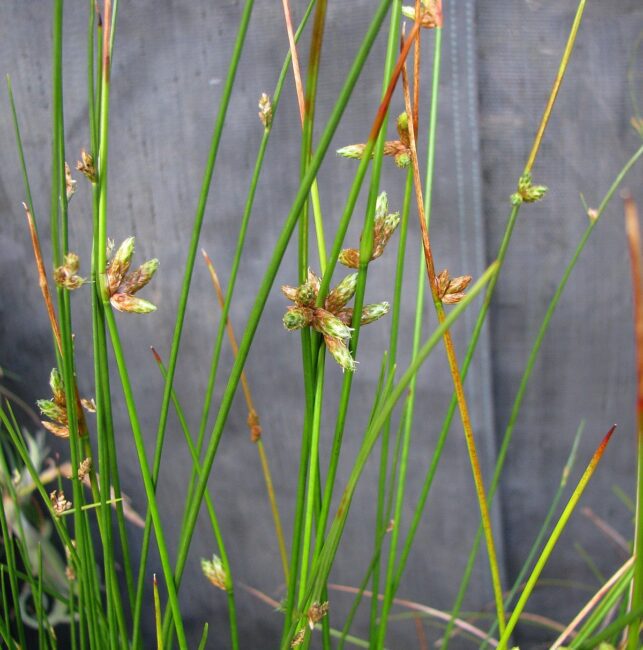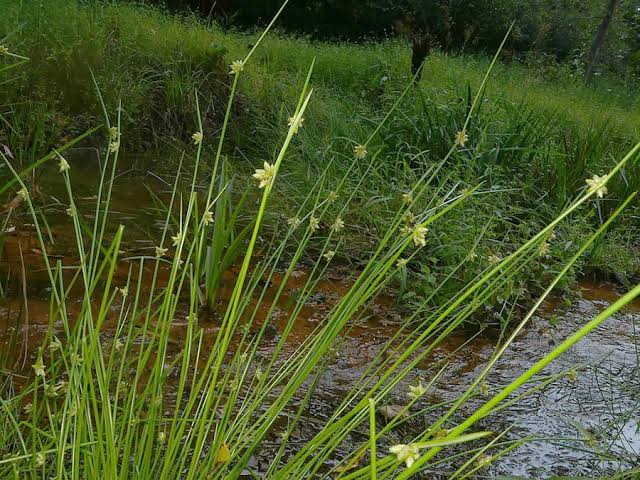Weakstalk bulrush (Schoenoplectiella purshiana) is a type of plant that grows in wetlands. This plant has slender stems and long leaves, making it distinct in its appearance. It is often found near the edges of ponds, lakes, and marshes.
This bulrush species plays a crucial role in the ecosystem by providing habitat and food for various wildlife. Birds, insects, and small mammals find refuge in the dense growth of Weakstalk bulrush. The plant’s leaves offer shade and protection, creating a suitable environment for these creatures.
One notable characteristic of Weakstalk bulrush is its adaptability to different water conditions. It can thrive in both shallow and deep waters, showcasing its resilience in various wetland ecosystems. This adaptability makes it a versatile and hardy plant, capable of withstanding changing environmental conditions.
The growth cycle of Weakstalk bulrush is intriguing. It begins its life as a seed, which germinates in the moist soil of wetlands. As it matures, the plant develops its distinctive stems and leaves, reaching its full height. The reproduction of Weakstalk bulrush primarily occurs through seed dispersal, contributing to the plant’s distribution across wetland areas.
Beyond its ecological significance, Weakstalk bulrush also serves practical purposes for humans. Historically, indigenous communities utilized parts of this plant for various purposes. The stems, for instance, were woven into baskets and mats, showcasing the plant’s cultural importance.
Understanding the lifecycle and ecological role of Weakstalk bulrush emphasizes its importance in maintaining the balance of wetland ecosystems. As we continue to appreciate and study the intricacies of nature, the significance of seemingly humble plants like Weakstalk bulrush becomes more apparent, reminding us of the interconnectedness of all living things.
Read Also: Natural Mating vs Artificial Insemination: Find out which is Better
How To Grow Weakstalk Bulrush (Schoenoplectiella purshiana)

Growing Weakstalk bulrush (Schoenoplectiella purshiana) can be a rewarding endeavor, especially for those interested in wetland plants. Here’s a simple guide on how to grow Weakstalk bulrush:
1. Choose the Right Location: Select a site with wet or marshy conditions, mimicking the natural habitat of Weakstalk bulrush. Ensure the soil is consistently moist, as this plant thrives in saturated environments.
2. Obtain Seeds or Seedlings: Acquire Weakstalk bulrush seeds or seedlings from a reputable nursery or supplier. If starting from seeds, consider soaking them in water for a day to promote germination.
3. Planting: Place the seeds or seedlings in the prepared wetland area. Ensure they are submerged in water or planted in soil that remains consistently moist. Planting can be done directly in the ground or in containers if you’re working with a controlled environment.
4. Watering: Maintain a consistent water level around the Weakstalk bulrush. Regularly water the plants, especially during dry periods, to keep the soil consistently moist. Adequate water is crucial for the proper growth of this species.
5. Sunlight: Weakstalk bulrush generally prefers full sunlight, so choose a location that receives ample sunlight throughout the day. Ensure that the plants get at least six hours of direct sunlight for optimal growth.
6. Fertilization (Optional): In their natural habitat, Weakstalk bulrushes often grow in nutrient-rich wetlands. If your soil lacks nutrients, you may consider adding a slow-release fertilizer. However, in many cases, these plants can thrive without additional fertilization.
7. Maintenance: Weakstalk bulrush is known for its low maintenance requirements. Regularly check the water level, and remove any weeds or debris that may hinder the plant’s growth. Pruning is generally not necessary unless you want to manage the plant’s size.
8. Monitor Growth: Observe the growth of your Weakstalk bulrush over time. As they mature, they will develop the characteristic slender stems and long leaves. If you’re growing these plants for their ecological benefits, take note of any wildlife that may be attracted to the area.
By following these simple steps, you can cultivate a thriving stand of Weakstalk bulrush and contribute to the health of wetland ecosystems. Remember to be mindful of the specific needs of this plant and its natural habitat throughout the growing process.
How To Care For Weakstalk Bulrush (Schoenoplectiella purshiana)
Caring for Weakstalk bulrush (Schoenoplectiella purshiana) involves understanding and mimicking its natural habitat. Here’s a guide on how to care for Weakstalk bulrush:
1. Watering: Weakstalk bulrush naturally grows in wetlands, so maintaining consistently moist soil is crucial. Regularly check the water level and ensure that the plant remains submerged or planted in soil that stays wet. Adequate water is vital for its overall health and growth.
2. Sunlight: Provide your Weakstalk bulrush with plenty of sunlight. Choose a location where the plant can receive at least six hours of direct sunlight each day. This mimics its natural habitat, promoting healthy growth and development.
3. Soil: Weakstalk bulrush prefers soils with high organic content. If you’re growing it in a container, use a mix of soil and peat moss to retain moisture. In natural settings, these plants often grow in nutrient-rich soils found in wetlands.
4. Temperature: These plants are adaptable to various temperature conditions but thrive in warmer climates. Ensure that the temperature doesn’t drop significantly, especially during colder seasons, to prevent stress on the plant.
5. Pruning (Optional): While Weakstalk bulrush generally requires minimal pruning, you may trim back dead or damaged stems if needed. This helps maintain the plant’s appearance and allows for new growth.
6. Wildlife Interaction: If you’re cultivating Weakstalk bulrush for its ecological benefits, observe the wildlife attracted to the area. These plants can provide habitat and food for birds, insects, and small mammals. Monitor how the plant interacts with the local ecosystem.
7. Fertilization (Optional): In its natural habitat, Weakstalk bulrush often grows in nutrient-rich wetlands. If your soil lacks nutrients, you can consider adding a slow-release fertilizer. However, many times these plants can thrive without additional fertilization.
8. Weed Control: Keep the area around your Weakstalk bulrush clear of weeds and debris. Weeds can compete for nutrients and water, potentially affecting the health of your plants. Regularly remove any unwanted vegetation.
9. Monitor for Pests: Keep an eye out for pests that may affect Weakstalk bulrush. While these plants are generally hardy, occasional checks for pests such as aphids or caterpillars can help address issues early.
By paying attention to these care guidelines, you can cultivate a healthy and thriving stand of Weakstalk bulrush, whether in a controlled environment or a natural wetland setting. Mimicking its native conditions will contribute to the overall well-being of the plant.
Read Also: The Importance and Uses of Hay
The Uses of Weakstalk Bulrush (Schoenoplectiella purshiana)

Weakstalk bulrush (Schoenoplectiella purshiana) has various uses, ranging from ecological to practical applications. Here are some notable uses of Weakstalk bulrush:
1. Ecological Importance: Weakstalk bulrush plays a crucial role in wetland ecosystems. Its dense growth provides habitat and shelter for a variety of wildlife, including birds, insects, and small mammals. The plant contributes to the overall biodiversity of wetland areas.
2. Erosion Control: The extensive root system of Weakstalk bulrush helps stabilize soil along the edges of water bodies. This makes it effective in preventing soil erosion, especially in areas prone to water movement.
3. Water Filtration: The root system of Weakstalk bulrush aids in water filtration by trapping sediments and absorbing excess nutrients. This natural filtration process contributes to improving water quality in wetland environments.
4. Traditional Uses: Historically, indigenous communities have utilized Weakstalk bulrush for various purposes. The plant’s stems were often woven into baskets, mats, or other traditional crafts. This highlights the cultural significance of the plant in certain communities.
5. Wildlife Forage: The seeds and stems of Weakstalk bulrush serve as a food source for many wildlife species. Birds, in particular, may feed on the seeds, contributing to their diet and supporting the overall food web in wetland ecosystems.
6. Restoration Projects: Weakstalk bulrush is often used in wetland restoration projects. Planting these bulrushes helps recreate or enhance natural wetland habitats, contributing to the rehabilitation of degraded ecosystems.
7. Aesthetic Landscaping: In some cases, Weakstalk bulrush is used in landscaping projects to enhance the aesthetic appeal of water features. Its distinctive appearance, with slender stems and long leaves, can add visual interest to ponds or water gardens.
8. Soil Improvement: The decomposition of Weakstalk bulrush plant material contributes organic matter to the soil. This can improve soil structure and fertility over time, especially in areas with nutrient-poor soils.
9. Educational Purposes: Weakstalk bulrush serves as an educational tool, helping people learn about wetland ecosystems and the importance of native plant species. Educational institutions and nature reserves may use these plants to promote awareness and understanding of local flora and fauna.
Understanding and appreciating the diverse uses of Weakstalk bulrush underscore its ecological significance and its potential contributions to sustainable practices, habitat restoration, and cultural heritage.
Frequently Asked Questions (FAQs)
Q: What is Weakstalk bulrush (Schoenoplectiella purshiana)?
A: Weakstalk bulrush is a plant species commonly found in wetlands. It has slender stems and long leaves, and it plays a vital role in wetland ecosystems by providing habitat and food for various wildlife.
Q: Where does Weakstalk bulrush typically grow?
A: Weakstalk bulrush is often found near the edges of ponds, lakes, and marshes. It thrives in wet or marshy conditions, adapting to both shallow and deep waters.
Q: How do I grow Weakstalk bulrush?
A: To grow Weakstalk bulrush, choose a wetland-like location with consistently moist soil. Plant seeds or seedlings, provide ample sunlight, and maintain a regular watering schedule. It’s a relatively low-maintenance plant.
Q: What are the ecological benefits of Weakstalk bulrush?
A: Weakstalk bulrush contributes to wetland ecosystems by providing habitat and food for wildlife. Its root system helps stabilize soil, preventing erosion, and it assists in water filtration by trapping sediments.
Q: Can Weakstalk bulrush be used for landscaping?
A: Yes, Weakstalk bulrush can be used in landscaping projects to enhance water features. Its distinctive appearance adds visual interest to ponds or water gardens.
Q: Are there traditional uses for Weakstalk bulrush?
A: Historically, indigenous communities have woven Weakstalk bulrush stems into baskets, mats, and other traditional crafts, showcasing its cultural significance.
Q: How can Weakstalk bulrush contribute to wetland restoration?
A: Weakstalk bulrush is often used in wetland restoration projects to recreate or enhance natural wetland habitats, supporting the rehabilitation of degraded ecosystems.
Q: Is Weakstalk bulrush suitable for erosion control?
A: Yes, the extensive root system of Weakstalk bulrush helps stabilize soil along the edges of water bodies, making it effective for erosion control.
Q: Does Weakstalk bulrush have any uses for wildlife?
A: Yes, the seeds and stems of Weakstalk bulrush serve as a food source for wildlife, particularly birds. It supports the overall food web in wetland ecosystems.
Q: Can Weakstalk bulrush be grown in containers?
A: Yes, Weakstalk bulrush can be grown in containers using a mix of soil and peat moss. Ensure the container has adequate drainage to prevent waterlogging.
Read Also: 10 Reasons Why Food Workers Should Keep Garbage Cans Clean and Free of Buildup

